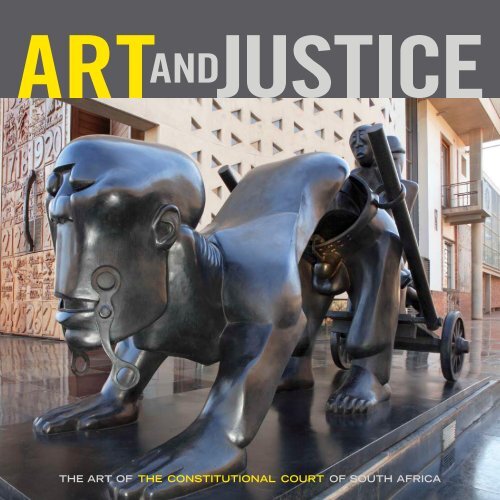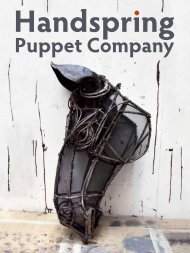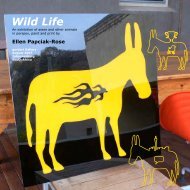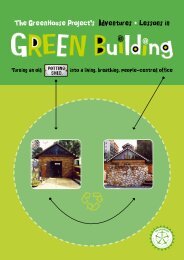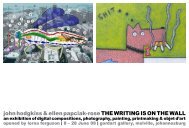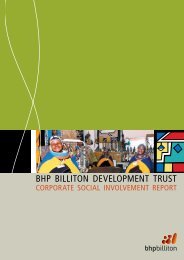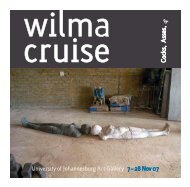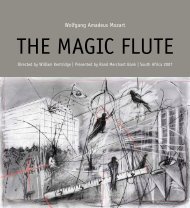the art of the constitutional court of south africa - ELLEN PAPCIAK ...
the art of the constitutional court of south africa - ELLEN PAPCIAK ...
the art of the constitutional court of south africa - ELLEN PAPCIAK ...
You also want an ePaper? Increase the reach of your titles
YUMPU automatically turns print PDFs into web optimized ePapers that Google loves.
THE ART OF THE CONSTITUTIONAL COURT OF SOUTH AFRICA
THE ART OF THE CONSTITUTIONAL COURT OF SOUTH AFRICA<br />
Photography by Ben Law-Viljoen
The publication <strong>of</strong> this book was made possible in p<strong>art</strong> by a grant<br />
from <strong>the</strong> Ford Foundation<br />
COPYRIGHT © 2008 OF ART AND JUSTICE<br />
The Constitutional Court Trust and David Krut Publishing<br />
COPYRIGHT © OF ALL PHOTOGRAPHS BY BEN LAW-VILJOEN<br />
The Constitutional Court Trust<br />
PROJECT COMMITTEE<br />
Carol Brown, Clive Kellner, Jane Lane, Bronwyn Law-Viljoen,<br />
Janina Masojada, Yvonne Mokgoro, Karel Nel, Ellen Papciak-Rose,<br />
Albie Sachs, Kate Savage, Carol Steinberg, Johann van der Westhuizen<br />
PHOTOGRAPHER<br />
Ben Law-Viljoen<br />
DESIGNER<br />
Ellen Papciak-Rose, www.ellenpapciakrose.com<br />
EDITOR AND PROJECT MANAGER<br />
Bronwyn Law-Viljoen<br />
IMAGE CONSULTANT<br />
John Hodgkiss<br />
ISBN 978-0-9584975-5-8<br />
Printed by Keyprint, Johannesburg<br />
Distributed in South Africa by<br />
David Krut Publishing, cc<br />
140 Jan Smuts Avenue<br />
Parkwood<br />
2193 South Africa<br />
t +27 (0)11 880 5648<br />
f +27 (0)11 880 6368<br />
Distributed in North America by<br />
David Krut Projects<br />
526 West 26 th Street, #816<br />
New York, NY<br />
10001 USA<br />
t +1 212 255 3094<br />
f +1 212 400 2600<br />
www.davidkrutpublishing.com<br />
www.davidkrut.com<br />
www.<strong>constitutional</strong><strong>court</strong>.org.za<br />
PREVIOUS: The Court in session during<br />
<strong>the</strong> case Shilubana and O<strong>the</strong>rs vs<br />
Nwamitwa. The case concerned <strong>the</strong><br />
right <strong>of</strong> a woman to ascend to <strong>the</strong><br />
chieftainship <strong>of</strong> <strong>the</strong> Valoyi community<br />
in Limpopo.<br />
RIGHT: Georgie Papageorge, Through <strong>the</strong><br />
Barrier – 1956 Treason Trial Frieze and<br />
Ladder, installed in <strong>the</strong> Foyer by Charl<br />
van der Merwe
Message<br />
Chief Justice Pius Langa 11<br />
Foreword<br />
Justice Ruth Bader Ginsburg 11<br />
1 Introduction 15<br />
Art and Freedom<br />
by Justice Albie Sachs 17<br />
Art and Architecture<br />
by Andrew Makin 37<br />
Calling all Artists, Crafters and Designers<br />
by Janina Masojada 38<br />
2 Building with Art 41<br />
3 Variety and Individual Expression 63<br />
4 Collective Creativity 81<br />
5 Craft Transformed 95<br />
6 Collecting Art for a Court 111<br />
Art and Justice<br />
by Bronwyn Law-Viljoen and Karel Nel 113<br />
7 Three Sentinels for an Art Collection 183<br />
Appendix<br />
The Art Collection 195<br />
Integrated Artworks 200<br />
Acknowledgements 203
MESSAGE FROM CHIEF JUSTICE PIUS LANGA<br />
The Justices <strong>of</strong> <strong>the</strong> Constitutional Court <strong>of</strong> South Africa have <strong>the</strong> privilege <strong>of</strong> working in a beautiful environment.<br />
Every day, as we try to answer difficult questions concerning fundamental human rights, <strong>the</strong> moving<br />
works <strong>of</strong> <strong>art</strong> and uplifting design <strong>of</strong> our building constantly remind us <strong>of</strong> what should never be forgotten: that<br />
justice is for people and that all people are united in <strong>the</strong>ir inherent human dignity. My hope is that this spirit<br />
<strong>of</strong> shared humanity, so clearly conveyed by <strong>the</strong> Court’s collection, will continue to inspire judges and<br />
ordinary people alike in our collective pursuit <strong>of</strong> justice.<br />
OPPOSITE: Judith Mason, Flower, 2006,<br />
linocut, 76 x 57 cm<br />
OVERLEAF: Chandeliers by Walter Oltmann<br />
creating a leafy canopy in <strong>the</strong> Foyer<br />
Pius Langa<br />
Chief Justice, Constitutional Court <strong>of</strong> South Africa<br />
FOREWORD BY JUSTICE RUTH BADER GINSBURG<br />
The Constitution <strong>of</strong> <strong>the</strong> Republic <strong>of</strong> South Africa marks <strong>the</strong> birth <strong>of</strong> a new nation<br />
dedicated to “democratic values, social justice and fundamental human rights.” 1<br />
It is fitting that <strong>the</strong> judicial guardian <strong>of</strong> <strong>the</strong> Constitution, <strong>the</strong> Constitutional Court,<br />
is housed in a building notable for its accessibility to <strong>the</strong> public, as <strong>the</strong> Court<br />
itself is. Constructed on <strong>the</strong> site <strong>of</strong> <strong>the</strong> Old Fort Prison where Nelson Mandela<br />
and Mahatma Gandhi were once locked up, <strong>the</strong> Court incorporates p<strong>art</strong> <strong>of</strong> that<br />
fearsome edifice. Empty cells, barbed wire and some <strong>of</strong> <strong>the</strong> <strong>art</strong>work serve as<br />
reminders <strong>of</strong> past tears and travail, and <strong>the</strong> long struggle for freedom. Overall,<br />
however, <strong>the</strong> building’s design expresses high hope for, and abiding faith in,<br />
“a united and democratic South Africa able to take its rightful place as a<br />
sovereign state in <strong>the</strong> family <strong>of</strong> nations.” The Constitution, Court building and<br />
<strong>art</strong>work share an animating <strong>the</strong>me: “Everyone has inherent dignity and <strong>the</strong> right<br />
to have <strong>the</strong>ir dignity respected and protected.”<br />
The <strong>art</strong> displayed in <strong>the</strong> Court is a perfect match for <strong>the</strong> building’s design. The<br />
collection affords <strong>the</strong> visitor, and all who work at <strong>the</strong> Court, a moving and delightful<br />
impression at every step and turn. Imbued with <strong>the</strong> spirit <strong>of</strong> emancipated humanity,<br />
it is <strong>the</strong> most vibrant collection I have seen in any <strong>court</strong>house in <strong>the</strong> world.<br />
None <strong>of</strong> <strong>the</strong> Renaissance iconography typically shown in tribunals <strong>of</strong> justice<br />
and no austere portraits <strong>of</strong> judges <strong>of</strong> yesteryear (invariably white and invariably<br />
male) fill <strong>the</strong> Constitutional Court’s foyers, corridors and rooms. 2 Instead, <strong>the</strong> <strong>art</strong><br />
is <strong>of</strong>, by, and for “<strong>the</strong> people <strong>of</strong> South Africa,” now “united in [<strong>the</strong>ir] diversity.”<br />
Approaching <strong>the</strong> building, one sees on <strong>the</strong> façade <strong>the</strong> Court’s name, in<br />
bright colors, in <strong>the</strong> many tongues spoken in South Africa. The arrangement<br />
conveys to <strong>the</strong> entrant: whatever your race, language or station, you are<br />
welcome here. Inside, <strong>the</strong> talent and spirit <strong>of</strong> <strong>the</strong> nation’s <strong>art</strong>ists and crafters<br />
combine to create a brilliant homage to what South Africa is becoming:<br />
“a democratic and open society in which government is based on <strong>the</strong> will <strong>of</strong> <strong>the</strong><br />
people and every citizen is equally protected by law.”<br />
Some <strong>of</strong> <strong>the</strong> <strong>art</strong>makers are internationally renowned; o<strong>the</strong>rs perhaps do not<br />
even think <strong>of</strong> <strong>the</strong>mselves as <strong>art</strong>ists, <strong>the</strong>y simply make beautiful things. Among<br />
<strong>the</strong> most evocative works in <strong>the</strong> collection is <strong>the</strong> famed “Blue Dress” triptych 3<br />
by Judith Mason, a gentle memorial to an executed ANC combatant whose<br />
naked body, covered only with a scrap <strong>of</strong> blue plastic, had been found as a<br />
result <strong>of</strong> Truth and Reconciliation Commission proceedings. Willem Bosh<strong>of</strong>f’s<br />
granite tablets recording each day <strong>of</strong> <strong>the</strong> decades Nelson Mandela and <strong>the</strong><br />
o<strong>the</strong>r Rivonia defendants spent in prison similarly remind viewers <strong>of</strong> <strong>the</strong> years <strong>of</strong><br />
division, oppression and pain under apar<strong>the</strong>id. Emblematic <strong>of</strong> <strong>the</strong> transformation<br />
<strong>of</strong> <strong>the</strong> nation from a racist, authoritarian state into a <strong>constitutional</strong> democracy<br />
are <strong>the</strong> carpets, alive with color, woven by rural women using designs adapted<br />
from paintings by <strong>the</strong> <strong>art</strong>ists Simphiwe Zulu, Romeo Zamane Makhanya and<br />
Sfiso Ka-Mkame; <strong>the</strong> finely wrought security gates; <strong>the</strong> woven chandeliers; <strong>the</strong><br />
carved doors; <strong>the</strong> slightly irregular round table at which <strong>the</strong> Justices confer;<br />
and <strong>the</strong> Court’s logo symbolising “justice under a tree”. Throughout, one sees<br />
<strong>the</strong> imprint <strong>of</strong> <strong>the</strong> hands, eyes and imaginations <strong>of</strong> all <strong>the</strong> people whom <strong>the</strong><br />
Constitution, and laws made <strong>the</strong>reunder, exist to serve.<br />
On my visit to <strong>the</strong> Court in 2006, I had <strong>the</strong> very best tour guide in Justice<br />
Albie Sachs, whose bright mind, caring he<strong>art</strong>, eternal optimism and indomitable<br />
spirit have inspired legions <strong>of</strong> jurists round <strong>the</strong> world. His appreciation <strong>of</strong> <strong>the</strong><br />
alliance between <strong>art</strong> and justice, and his skill in <strong>the</strong> fine <strong>art</strong> <strong>of</strong> persuasion, have<br />
contributed enormously to <strong>the</strong> remarkable collection previewed in <strong>the</strong> following<br />
pages, and in <strong>the</strong> companion DVD. When Albie asked me to write a preface for<br />
this extraordinary, spirit-lifting publication, what could I do but just say, “yes”?<br />
Ruth Bader Ginsburg<br />
Associate Justice, Supreme Court <strong>of</strong> <strong>the</strong> United States<br />
1 This and o<strong>the</strong>r quotations are from <strong>the</strong> Constitution <strong>of</strong> <strong>the</strong> Republic <strong>of</strong> South Africa (1996).<br />
2 J. Resnik and D. Curtis, Representing Justice: From Renaissance Iconography to Twenty-First-Century<br />
Courthouses, 151 Proceedings <strong>of</strong> <strong>the</strong> American Philosophical Society 139 (2007), 179-180.<br />
3 The title <strong>of</strong> <strong>the</strong> work is The Man Who Sang and <strong>the</strong> Woman Who Kept Silent.<br />
Message and Foreword /<br />
11
BUILDING WITH ART<br />
SECURITY GATES, ENTRANCE DOORS, SIGNAGE, SUN SCREENS, MOSAIC BENCH<br />
The design brief for <strong>the</strong> new Constitutional Court stipulated <strong>the</strong> physical requirements <strong>of</strong> <strong>the</strong> building<br />
(<strong>the</strong> spatial relationship between rooms and <strong>the</strong> needs <strong>of</strong> <strong>the</strong> people using <strong>the</strong>m, for example) and <strong>the</strong><br />
performance requirements (to be water-pro<strong>of</strong>, acoustically sound, visually accessible and so on).<br />
In addition, and just as important as <strong>the</strong>se pragmatic considerations, was <strong>the</strong> brief that <strong>the</strong> building have<br />
meaning and relevance: that it express our collective social, political and cultural achievement in <strong>the</strong> context<br />
<strong>of</strong> <strong>the</strong> new South African democracy and contribute to an ever-evolving national cultural identity. Meaning<br />
and experience were constantly interrogated in <strong>the</strong> design process and were <strong>the</strong> major <strong>the</strong>mes <strong>of</strong> a debate<br />
that helped to refine <strong>the</strong> architectural response to <strong>the</strong> project.<br />
In <strong>the</strong> design development <strong>of</strong> <strong>the</strong> Court, <strong>the</strong> fundamental intention was for <strong>the</strong> building to be unified with<br />
<strong>the</strong> South African context expressed in and promised by <strong>the</strong> country’s new Constitution. The architects<br />
responded to this brief on an urban and architectural scale, as well as in terms <strong>of</strong> <strong>the</strong> elements <strong>of</strong> <strong>the</strong><br />
building (<strong>the</strong> bits and pieces making <strong>the</strong> whole). Artists and craftspeople were invited to p<strong>art</strong>icipate in <strong>the</strong><br />
building’s make-up by submitting proposals for <strong>the</strong>se elements, some quite small (like <strong>the</strong> nosings on <strong>the</strong><br />
stairs in <strong>the</strong> Exhibition Gallery, pp. 108-109) and some much larger interventions (such as <strong>the</strong> westelevation<br />
sun screens, pp. 36, 56-59).<br />
The traditional supply chain for such elements was replaced by <strong>art</strong>ists and craftspeople who conceptualised<br />
and customised many <strong>of</strong> <strong>the</strong> building components. These had to respond to functional (building performance)<br />
requirements and physical environments, but also bring meaning – human energy, creativity and a vibrant<br />
aes<strong>the</strong>tic – to <strong>the</strong> building.<br />
PREVIOUS: Judges’ Wing (level -1) with<br />
Sipho Ndlovu, Images <strong>of</strong> South African History<br />
1, 2, 3, 4, c1998, acrylic on canvas, each<br />
152 x 122 cm<br />
OPPOSITE: Security gate in <strong>the</strong> Judges’ Wing<br />
(level -1) by Lisa Perold<br />
42<br />
\ Building with Art
SECURITY GATES FOR THE JUDGES’ CHAMBERS<br />
The practical requirement for security for <strong>the</strong><br />
Judges’ Chambers meant <strong>the</strong> development <strong>of</strong><br />
a brief that described <strong>the</strong> physical properties<br />
(location, size) <strong>of</strong> a set <strong>of</strong> gates, <strong>the</strong>ir required<br />
performance (security control, visibility) and <strong>the</strong><br />
meaning <strong>of</strong> “security” in <strong>the</strong> context <strong>of</strong> <strong>the</strong> history<br />
<strong>of</strong> incarceration. The Court is built on <strong>the</strong> site <strong>of</strong> a<br />
former prison, which meant that <strong>the</strong> question <strong>of</strong><br />
<strong>the</strong> physical requirements <strong>of</strong> security (gates and<br />
bars) had to be treated with p<strong>art</strong>icular sensitivity.<br />
This concern was conveyed to <strong>the</strong> <strong>art</strong>ists who won<br />
<strong>the</strong> commission to design <strong>the</strong> gates.<br />
Fourteen pairs <strong>of</strong> security gates, designed<br />
and made by a team <strong>of</strong> <strong>art</strong>ists and fabricators,<br />
were delivered to <strong>the</strong> Court from across <strong>the</strong><br />
country for <strong>the</strong> builders to fit into <strong>the</strong> building<br />
fabric. Each pair <strong>of</strong> gates is unique and, given<br />
<strong>the</strong> range <strong>of</strong> material used in <strong>the</strong>ir construction<br />
and <strong>the</strong> <strong>art</strong>istic styles to which <strong>the</strong>y give<br />
expression, <strong>the</strong>y have become a “collection”<br />
<strong>of</strong> works – integrated into <strong>the</strong> building – that<br />
show <strong>of</strong>f individual <strong>art</strong>istic and technical talent,<br />
inventiveness and a diversity <strong>of</strong> skills.<br />
LEFT: View into secretaries’ <strong>of</strong>fices on <strong>the</strong><br />
ground, first and second floors <strong>of</strong> <strong>the</strong><br />
Judges' Wing<br />
OPPOSITE LEFT: Security gates leading to<br />
<strong>the</strong> Chambers <strong>of</strong> Justice Tholakele Madala<br />
OPPOSITE RIGHT: Security gates leading to<br />
<strong>the</strong> Chambers <strong>of</strong> Justice Yvonne Mokgoro<br />
44
CRAFT TRANSFORMED<br />
CHANDELIERS, LAMPS, COURT CHAMBER DOORS, NOSINGS<br />
Many <strong>of</strong> <strong>the</strong> lighting systems in <strong>the</strong> Court demonstrate <strong>the</strong> combination <strong>of</strong> traditional and industrial<br />
technologies. For some <strong>of</strong> <strong>the</strong> lights, for example, recycled strips <strong>of</strong> aluminium and brass were woven into<br />
hanging lanterns and chandeliers. While <strong>the</strong> lights are modern – <strong>the</strong>ir forms simple and appropriate to <strong>the</strong><br />
architectural language <strong>of</strong> <strong>the</strong> Court building – <strong>the</strong>y allude to <strong>the</strong> traditional craft <strong>of</strong> basketry used in <strong>the</strong><br />
making <strong>of</strong> containers and fish traps.<br />
For o<strong>the</strong>r lights, vertical tubes were woven from saplings and painted white on one side for greater<br />
reflectivity, <strong>the</strong>ir elongated shapes alluding to trees but also, once again, to baskets. And in still o<strong>the</strong>r lights,<br />
aluminium cable was woven to form petals and leaves attached to branches that form reflective, tree-like<br />
canopies below <strong>the</strong> Foyer ceiling.<br />
The lights for <strong>the</strong> Staff Canteen incorporate photographs <strong>of</strong> South African urban and rural landscapes. To<br />
complement this imagery, gas-stays traditionally used for vehicle hatch-backs support <strong>the</strong> Canteen’s tip-up<br />
screens made from woven Zintingo saplings. All <strong>of</strong> <strong>the</strong>se processes serve to demonstrate <strong>the</strong> transformation<br />
<strong>of</strong> traditional crafting techniques and objects: basketry is alluded to but recontextualised in <strong>the</strong> setting<br />
provided by <strong>the</strong> Court and weaving is given a dynamic and modern interpretation.<br />
Several o<strong>the</strong>r <strong>of</strong> <strong>the</strong> Court furnishings reinterpret traditional craft in innovative ways. The patterns on <strong>the</strong><br />
nosings that edge <strong>the</strong> stairs in <strong>the</strong> Exhibition Gallery are adapted from <strong>the</strong> markings used in clay pottery to<br />
decorate pots and o<strong>the</strong>r vessels. The large Court Chamber doors suggest <strong>the</strong> weft and weave <strong>of</strong> Kente cloth,<br />
but translated into <strong>the</strong> warmth and solidity <strong>of</strong> metal.<br />
PREVIOUS: View <strong>of</strong> <strong>the</strong> Foyer showing<br />
Walter Oltmann’s wire chandeliers forming a<br />
“canopy” <strong>of</strong> leaves and Jane du Rand’s vibrant<br />
mosaics on <strong>the</strong> slanted concrete pillars<br />
OPPOSITE: Detail <strong>of</strong> wire chandeliers by<br />
Walter Oltmann<br />
96<br />
\ Craft Transformed
194
Johannes Maswanganyi, Perfect<br />
Paradise, undated, wood and paint,<br />
115 x 129 x 150 cm<br />
THE ART COLLECTION<br />
Lionel Abrams, Family Portraits (Proust series),<br />
1991, acrylic on canvas<br />
Albert Adams, Te<strong>the</strong>red Monkey, undated,<br />
acrylic on canvas [p. 142]<br />
Ayo Aina, Old and New, 1999, mixed media<br />
Aminsha, Mermaid, undated, batik on cloth<br />
Aminsha, Turtle, undated, batik on cloth<br />
Paul Andrew, Near Graaf-Reinet, Karoo, 1996,<br />
watercolour on paper<br />
Tyrone Appollis, Kalk Bay, 1996, oil on board<br />
Philip Badenhorst, Peace <strong>of</strong> Mind, “Images <strong>of</strong><br />
Human Rights Portfolio”, 1996, linocut [p. 176]<br />
Samuel Bak, Star Hole, undated, pastel on paper<br />
John Baloyi, Godzilla, 2004, wood [p. 185]<br />
John Baloyi, Ghost, 2004, wood [p. 32]<br />
Regi Bardavid, Grief No 1, 1990, conté<br />
crayon and charcoal on paper [p. 154]<br />
Regi Bardavid, Grief No 2, 1990, conté<br />
crayon and charcoal on paper [p. 154]<br />
Regi Bardavid, Grief No 3, 1990, conté<br />
crayon and charcoal on paper [p. 154]<br />
Regi Bardavid, Grief No 4, 1990, conté<br />
crayon and charcoal on paper [p. 155]<br />
Regi Bardavid, Grief No 5, 1990, conté<br />
crayon and charcoal on paper [p. 155]<br />
Kim Berman, Political Rights, “Images <strong>of</strong><br />
Human Rights Portfolio”, 1996, drypoint and<br />
monotype [p. 178]<br />
Kim Berman, Alex Under Siege 1, 1988,<br />
drypoint and monotype [p. 134]<br />
Kim Berman, Alex Under Siege 3, 1988,<br />
drypoint and monotype [p. 134]<br />
Kim Berman, Alex Under Siege 5, 1988,<br />
drypoint and monotype [p. 135]<br />
Kim Berman, Alex Under Siege 7, 1988,<br />
drypoint and monotype [p. 135]<br />
Kim Berman, Fires <strong>of</strong> <strong>the</strong> Truth Commission 1,<br />
2000, monotype [p. 136]<br />
Kim Berman, Fires <strong>of</strong> <strong>the</strong> Truth Commission 3,<br />
2000, monotype [p. 136]<br />
Kim Berman, Fires <strong>of</strong> <strong>the</strong> Truth Commission 5,<br />
2000, monotype [p. 137]<br />
Kim Berman, Fires <strong>of</strong> <strong>the</strong> Truth Commission 7,<br />
2000, monotype [p. 137]<br />
Hilda Bernstein, African Elephant, undated,<br />
etching<br />
Willie Bester, Discussion, 1994, wool [pp. 4-5]<br />
Be<strong>the</strong>sda Arts Centre, The Truth Tree, 2007,<br />
fabric appliqué<br />
Be<strong>the</strong>sda Arts Centre, Sun and Moon, 2007,<br />
fabric appliqué<br />
BK, Still Life with Musical Instruments, 1998,<br />
coloured sand on canvas on board<br />
Bongiwe, Body Map, 2002, digital inkjet print<br />
on paper [p. 165]<br />
Willem Bosh<strong>of</strong>f, Prison Hacks, 2003, 8 granite<br />
slabs [pp. 128-129, 131]<br />
Claude Bouscharain, Expectation, 1968,<br />
acrylic on canvas<br />
Kami Brodie, Papa and M<strong>art</strong>ha, 1992, oil and<br />
acrylic on canvas<br />
Kami Brodie, Iris, Working Woman, 1998, oil<br />
and acrylic on canvas<br />
Kami Brodie, Three Working Women: Anna,<br />
Lizzie, Maggie, 1994, oil and acrylic on<br />
canvas<br />
Hamilton Budaza and Cecil Skotnes, Freedom,<br />
1995, engraved wood panels [pp. 24, 25]<br />
Ezekiel Budeli, Ancestral Kingdom, “Images<br />
<strong>of</strong> Human Rights Portfolio”, 1996, linocut<br />
[p. 174]<br />
Samkelo Bunu, Land and Property Right,<br />
“Images <strong>of</strong> Human Rights Portfolio”, 1996,<br />
woodcut [p. 175]<br />
Norman Ca<strong>the</strong>rine, Speaker <strong>of</strong> <strong>the</strong> House,<br />
1989, canvas, metal, wood and acrylic [p. 33]<br />
Gail Catlin, Woman, 1993, gouache on paper<br />
Babalwa Cekiso, Body Map, 2002, digital<br />
inkjet print on paper<br />
Appendix – The Art Collection /<br />
195
Ben Law-Viljoen has worked as an electrical engineer, a building<br />
project manager, a 4 x 4 mechanic and a photographic printmaker, juggling<br />
freelance photography with all <strong>of</strong> <strong>the</strong>se activities since 1991. He has a degree<br />
in Biochemistry from Rhodes University where he also studied photography<br />
and colour printing under Obie Oberholzer. He lived in New York for ten<br />
years, working for a fine-<strong>art</strong> printing lab and as first assistant to a busy New<br />
York fashion photographer, before returning to South Africa in 2006.<br />
Ellen Papciak-Rose is an <strong>art</strong>ist, graphic designer and illustrator.<br />
Originally from <strong>the</strong> USA, she has lived in sou<strong>the</strong>rn Africa for <strong>the</strong> past<br />
eighteen years. In 1989 she moved to Botswana to teach <strong>art</strong> in two rural<br />
villages, and in 1995 relocated to Johannesburg. Her design and illustration<br />
focus on community issues, cultural projects and <strong>the</strong> work <strong>of</strong> o<strong>the</strong>r <strong>art</strong>ists.<br />
She has won two American Graphic Design Awards and is widely published<br />
in design and illustration publications. In 2006 she was awarded an<br />
Ampersand Foundation Fellowship in New York and in 2007 she was one <strong>of</strong><br />
<strong>the</strong> creative speakers at AdobeLive. www.ellenpapciakrose.com<br />
Bronwyn Law-Viljoen, <strong>the</strong> co-ordinator <strong>of</strong> this project and editor<br />
<strong>of</strong> Art and Justice, is a former Fulbright scholar who completed her doctorate<br />
in literature at New York University. In her capacity as Managing Editor <strong>of</strong><br />
David Krut Publishing, she has edited a number <strong>of</strong> titles including Light<br />
on a Hill, TAXI-013 Diane Victor and William Kentridge Flute. She is also<br />
a freelance writer and has contributed essays on South African <strong>art</strong> and<br />
photography to a number <strong>of</strong> South African and international publications,<br />
including Art on Paper, Art South Africa, Aperture magazine, Printmaking<br />
Today and Scrutiny.<br />
Andrew Makin and Janina Masojada head omm design workshop<br />
in Durban, South Africa. Begun as a loose collaboration <strong>of</strong> architects,<br />
omm design workshop became formalised in 1997 following <strong>the</strong>ir winning <strong>of</strong><br />
<strong>the</strong> international architectural design competition for <strong>the</strong> new Constitutional<br />
Court <strong>of</strong> South Africa. Since <strong>the</strong>n <strong>the</strong>y have designed o<strong>the</strong>r landmark buildings<br />
around South Africa and won numerous awards. They have acted as concept<br />
designers for a number <strong>of</strong> important projects including <strong>the</strong> International<br />
Convention Centre Arena, Durban, <strong>the</strong> new King Shaka International Airport<br />
and <strong>the</strong> Dube Trade Port for <strong>the</strong> Province <strong>of</strong> KwaZulu-Natal.<br />
Paul Wygers, <strong>the</strong> Johannesburg-based p<strong>art</strong>ner for <strong>the</strong> design <strong>of</strong> <strong>the</strong><br />
Constitutional Court, heads Urban Solutions Architects and Urban<br />
Designers. The practice, established in 1994, focuses on <strong>the</strong> formulation<br />
and implementation <strong>of</strong> large-scale development frameworks. It is engaged<br />
in a variety <strong>of</strong> architectural and urban design projects, including a strategic<br />
public transport network study for Johannesburg, development feasibilities<br />
for a new city in <strong>the</strong> Middle East, coding and precinct design for developments<br />
throughout South Africa, residential works in Gauteng and <strong>the</strong><br />
Western Cape and <strong>the</strong>ir own developments in Johannesburg’s inner city.


